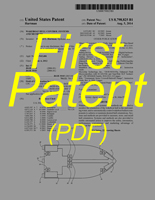
Why bother with patents?
Patents are important because they protect your investment in research and development (R&D). Our team has decades of experience in product development, and through painful experience we have learned that some people are willing to steal and copy your ideas for their own benefit. Patents are a government-issued monopoly. The owner of the patents is legally able to control who uses the technology. With R&D costs skyrocketing, it would be foolish not to protect such investments.
Our experience has taught us to start each new project by writing and filing patents that cover it. This allows the patent process to run in parallel with technology development, and usually at least one set of claims has already issued by the time we are ready to sell the complete Intellectual Property package. For WakeTouch multiple claims have indeed already issued, and multiple additional patents and continuations with dozens more claims have already been filed. All of this Intellectual Property will be included in the sale of the complete WakeTouch package.
We don't just deliver advanced technology. We also deliver the legal tools to protect and defend it. We deliver the whole package.
What do the patents cover?
A wide range of things, including but not limited to:
- WakeTouch hardware concept
- Advanced pump monitoring, safety, and control concepts
- Several other innovative products and ideas that we haven’t even started to implement (yet!)
The buyer of this intellectual property may capitalize on everything in the patents, including filing new patents based on the same specification that take advantage of the original application’s early priority date.
We have a lot of experience writing good patents. Our claims have broad scope (ask your own patent counsel what that means) and are fundamental to applying these concepts in actual products. We write claims that protect using a variety of different perspectives and combinations; those who might be tempted to "work around" the claims will find it exceedingly difficult to avoid infringement.
You don't have to take our word for it. A PDF version of the first issued patent is available here, and via the link at the top of this page. We encourage you to have your own legal staff review it. In particular, your patent counsel should consider what additional claims THEY could author based on the current specification by itself (via Continuations) or in combination with your own specifications (via Continuations in Part). We are careful to keep our filings active, and we have multiple applications pending from which your team can file additional applications and claims, phrased and worded to your liking, that reach back to the priority date of our original filing.
This is an exceptionally powerful opportunity to control the evolution of these assets for your company’s best benefit.
Can't we just ignore the patents?
This is a common error made by people who don't have much experience with patents and property rights. It's not just the original inventor that infringers need to worry about - it's the next owner. Companies pay for patents because patents protect their assets and give them a uniquely powerful position in the market, and you can be certain they are interested in protecting that investment. The next owner will want to enforce their rights.
It's also worth mentioning that willful patent infringement can lead to TRIPLE DAMAGES. Better to own the patents yourself than risk infringing them.
Can't we just get the patents invalidated?
Another common mistake. Each separate patent can contain many separate claims. Each claim stands on its own, each one protecting the patent owner's rights via a new and separate approach. Our team is very sensitive to this, and we are careful to write numerous claims that describe and protect our concepts in a variety of different ways.
Over 20 such claims have already issued, and we have dozens more actively pending. An infringer might get one or two invalidated with lengthy effort. But they'll never get them all, and it only takes one to prevail. Then the infringer is scrambling to deal with willful infringement, triple damages, cease and desist orders, loss of product lines, interruptions of marketing plans, angry dealers and customers, broken promises, embarrassment in the market... again, it's just not worth the risk.
What if we don’t bother offering WakeTouch?
That's your decision, but: Perhaps you can cheapen your products to make up for the savings you'll miss by not adopting WakeTouch-based instrumentation, but how will that affect your product acceptance in the marketplace? How will customers and industry experts rank your products against those that DO include these next-generation technologies? Do you really want to find out?
Back to Top of Page
|